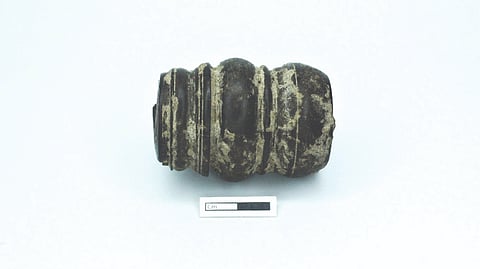

MADURAI: The rich storehouse of antiquities, has hogged the limelight at Keeladi and its cluster sites in Sivaganga district, especially with the recent finding of a remarkable bead made of ivory, during the eighth phase of archaeological excavations.
The excavations at Keeladi, a pre-Sangam (Iron Age) settlement, which commenced on February 12 this year, were carried out in nine quadrants, and the recent discovery of the ivory bead has turned out to be a surprise. The finest antique was unearthed from another quadrant, R. Sivanandam, Director of Archaeology, said on Sunday.
This unique specimen of bead made out of ivory was found in the quadrant XM13/4 at the depth of 164 cm. “It is relatively large in size for a bead. The object is cylindrical in shape with multiple segmented spirals observed and a hole is found running longitudinally which is well proportioned,” he said. Two bigger spiral segments, which are bulged, and three smaller spirals were observed in total on the lateral side of the object. The object measured 5.6 x 4.0 cm with a centre hole measured 1.3 cm in diameter. Both the ends of the object are flat.
Thousands of antiquities, including a terracotta human head figurine, an ivory dice,etc, found at Keeladi gave rational evidence as to where the ancient clan settled down in the area, which once was a fascinating picture of an urban centre, the Director said.
According to C Santhalingam, a Madurai based archaeologist (retired) and founder of Pandya Nadu Centre for Historical Research, there were several antique works of art made of ivory, but the discovery of ivory bead, which look designed, is a rare find, he told DT Next. Normally, ancient dice, comb and other ornaments made of ivory could be found in excavations. Hence, it was evident that Keeladi was rich in antiquities and once upon a time was a major industrial centre as revealed during the second phase of excavation.
S. Bose, a retired professor, Department of History and Tourism, said the Keeladi’s recent excavation proved the existence of an affluent community. The feudal landlords could have had their lived-in-feel at Keeladi, where the ‘Porkollar’ community otherwise known as ‘Achari’ lived with their superior professional craftsmanship in making of ornaments woodworks, Bose added further.
Visit news.dtnext.in to explore our interactive epaper!
Download the DT Next app for more exciting features!
Click here for iOS
Click here for Android